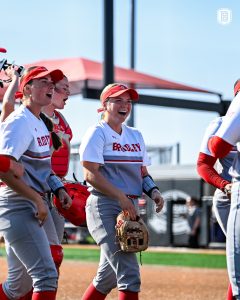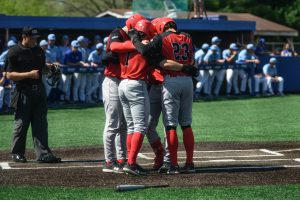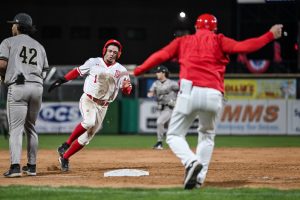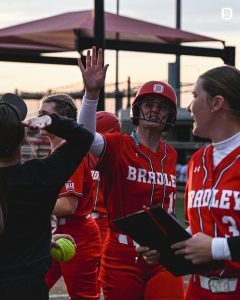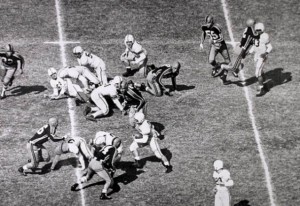
When you hear the phrase “Bradley University athletics,” chances are, you’ll immediately think of the men’s basketball team.
Among the NIT championships, NCAA tournament appearances and legendary players, Bradley basketball traditions revolve around the rivalry between Bradley and Illinois State University, which resides a mere 37 miles from Bradley down I-74.
But, what if I told you Bradley has more distinct ties with another Missouri Valley Conference (MVC) school?
On Feb. 20, another chapter in the ongoing relationship between Bradley and Drake University was unknowingly carved out in front of a crowd of 7,149.
Bradley was playing its 1,000th basketball game as a member of the MVC, and while it may have been coincidental the Braves played the Bulldogs that night, it was also fitting.
Bradley won the 145th meeting between the two programs 73-70, and the celebration ensued for the Braves’ victory in their 1,000th MVC game.
The 145 games between the two schools is also the most games Bradley has ever played against an opponent in program history, more so than the 122 times the Braves have played Illinois State.
The matchup also celebrated a game between two schools that formed an almost 70-year solidarity from their similarities.
Bradley and Drake
In the MVC, there are four private schools.
Two are non-secular: Evansville is a Methodist university, and Loyola is a Jesuit university. Bradley and Drake are secular institutions.
Paul Morrison, a consultant and historian for Drake Athletics and a former sports information director, noted the nuptial-type relationship between Bradley and Drake.
“We’re neighborhood schools as it were,” the 97-year-old said in a phone interview with The Scout. “We have strong emphasis on athletics, but we have a stronger emphasis on academics. So we’ve been very closely associated … If I had to describe it, it’s been a very nice marriage.”
While Morrison noted the close relationship between the two schools, former Bradley coach and player Joe Stowell said distance was a reason why Bradley and Drake’s relationship differs from Illinois State.
“Drake was in the conference the same time we were,” Stowell said. “This is not like Bradley and Illinois State because we’re [about] 55 to 40 miles from [ISU]. Bradley and Drake have always been a good rivalry.”
However, it took major controversy and animosity in order for the two schools to really come together and realize this bond.
“[There] was an international incident as it were, and Bradley stepped up immediately,” Morrison said. “It seems to me that’s been typical of the Bradley-Drake relationship over the years.”
This “international incident” happened almost 65 years ago on Lewis Field in Stillwater, Oklahoma, during what was called the “Johnny Bright Incident.”
The Johnny Bright Incident
The days leading up to Oct. 20, 1951, were lined with tensions.
Johnny Bright, a star senior quarterback for Drake University, was a Heisman Trophy candidate five weeks into the 1951 college football season.
Bright, who was labeled the “Great Negro Flash” by newspaper columnists at the time, led the nation in rushing at that point and was undoubtedly headed to NFL stardom following the 1951 season.
The Bulldogs were 5-0 and headed to Stillwater for a game against the Oklahoma A&M Aggies, who were the instigators of the aforementioned tensions.
Those tensions were formed by an open secret the Aggies were keeping up until that point.
The student and local newspapers in Stillwater were reporting that Aggies coach, J.B. Whitworth, had repeatedly told his players to “Get that n***er,” and the team adopted the phrase as their mantra.
It was obvious that Bright was a marked man, and this was proven in the first seven minutes of the game between the Aggies and Bulldogs.
“There was no question that they wanted to negate Johnny Bright’s performance,” Morrison said. “Even when he didn’t have the ball, they blocked him viciously. Cleanly, but viciously.”
The Aggies tackled Bright so roughly they knocked him unconscious three times. However, it all rose to a fever pitch when Aggie defensive tackle Wilbanks Smith hit Bright with a forearm to the face, breaking his jaw.
“Johnny had played there two years earlier as a sophomore and was just another ball player,” Morrison said. “By the time he played there as a senior, he was a nationally renowned figure. One way to negate Drake’s ability was to get Johnny out of the picture.”
Bright remained in the game, tossing a 61-yard touchdown to his fullback, but eventually left the game due to the injury.
The play might have fallen victim to history, but it just so happened that the Des Moines Register newspaper sent two photographers, Don Ultang and John Robinson, to cover the game.
“At that time the Register’s sports section was nationally renowned and they wanted to get photos,” Morrison said. “They didn’t know they had it early on film until they got back to Des Moines.”
The photographers caught the act on camera, and the violence has since been immortalized forever on the cover of the New York Times and in the archives of the Des Moines Register.
The Fall Out
There were many different consequences due to the Bright incident.
Oklahoma A&M, now Oklahoma State University, became a pariah seemingly overnight, and Smith, the perpetrator, was labeled a racist, something to which he vehemently denies today. Morrison, in defense of Smith, also adamantly says the incident was not racially motivated.
However, there were more positives as a result than there were negatives.
Bright played in the final three games of the 1951 season, but he didn’t see much action. He fully recovered from the incident, but it left an intangible scar.
Bright, fearing he’d get treated similarly in the NFL, elected to forgo his chance at the biggest stage in football, choosing to play in the Canadian Football League instead. He became a CFL legend before his untimely death in 1983.
The incident led to a change of rules in the NCAA, which brought about cleaner play and unconditional acceptance of black athletes in college sports.
“Up until that time, the football helmet was just a helmet,” Morrison said. “[The incident] was instrumental, history will show, in putting bars across the helmet.”
Another positive was the relationship between Drake and Bradley, which was conceived as a result of the incident.
On Nov. 28, 1951, the MVC announced it would take no action against Smith, who broke Bright’s jaw on that fateful day a month earlier.
“The conference has no authority to take disciplinary action against an individual player,” the MVC said in a statement, coldly washing their hands of the incident.
Drake severed its connections with the conference out of protest.
However, this did not come as a surprise, as it was well known that Drake would withdraw from the MVC had it not taken any action.
It turned out the university was not alone in this endeavor.
Solidarity, Sort Of
As Drake stood tall against the MVC in defense of Bright, Bradley was cementing a stand of its own.
The Peoria Journal Star reported rumors that Bradley was planning on following Drake out of the conference if the university did leave.
“I personally believe Bradley will follow Drake’s action, but the final decision rests with the Bradley faculty athletic committee,” David Blair Owen, president of Bradley from 1946 to1952, said to the Journal Star.
Owen’s beliefs didn’t take long to become reality.
On Nov. 29, the day after Drake withdrew from the MVC, Bradley followed Drake out in an act of perceived solidarity.
“I think they were sympathetic for Drake’s situation,” Morrison said.
Even Stowell, who saw things unfold from Bradley’s point of view, thought the same.
“We were in compassion with them, so we dropped out at the same time,” Stowell said.
A headline in the Journal Star read in large font, “BRADLEY FOLLOWS DRAKE OUT OF THE MISSOURI VALLEY,” announcing the completion of the split. However, Bradley’s reason for excommunicating themselves wasn’t assumed to be as morally sound as Drake’s.
Earlier in 1951, players on the Bradley men’s basketball team were found guilty of point shaving, or taking money from gamblers to fix basketball games and either covering or going against the published spread.
Following this scandal, which rocked the college basketball world, Bradley, who made it as far the NCAA Tournament title game in 1950, was denied its conference championship and trophy by the MVC as punishment.
The stand the MVC took against Bradley was, at the time, one of the only stands the conference took in recent memory.
According to an article in the Journal Star, the fact that the conference was willing to punish Bradley for point shaving and not Oklahoma A&M for what was deemed to be a racially stemmed incident enraged Bradley officials.
Then-Athletic Director Arthur Bergstrom sounded his anger clearly after Bradley vacated the Valley.
“They had the authority to take away the championships and individual awards from our basketball team,” Bergstrom said to the Journal Star in ‘51. “Yet, they say they didn’t have the right to rule on Bright. That again points up to the inconsistency of the conference.”
The Result
To this day, Bradley’s main Valley compatriot is listed as Illinois State, but that’s because of the short geographical distance between the two schools.
“Illinois State built their program up and eventually got into the Valley,” Stowell said. “They built the program up and, of course, people around there would like to play us. A lot of people from Peoria went to Illinois State. They had a lot of fans from this area.”
While there are those who endorse the rivalry with the Redbirds as one of the best in Bradley history, the relationship between the Braves and the Bulldogs remains as one of the longest running in the MVC.
If Bradley left the conference due to the anger Bergstrom and other Bradley officials had, there were those at Drake, and even those who were involved at Bradley, who were unaware of the real reason Bradley divorced the MVC.
Regardless, the relationship between the two schools remains one of the longest standing in the conference.
This was just one result of the Johnny Bright incident.
“Something good usually comes out of something bad, at least that’s my philosophy,” Morrison said. “It just proved the fine relationship we’ve had with Bradley over the years.”
